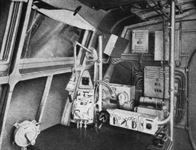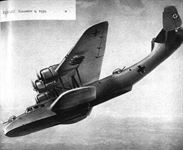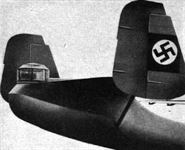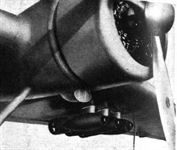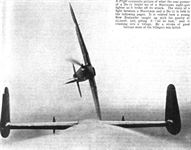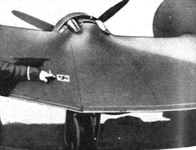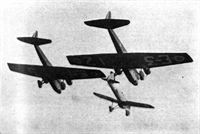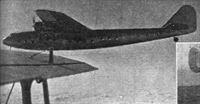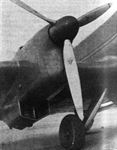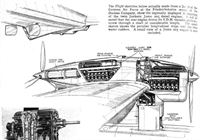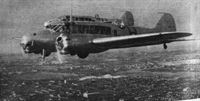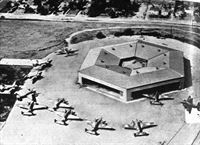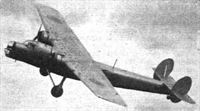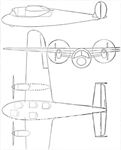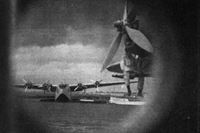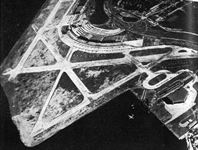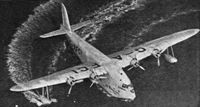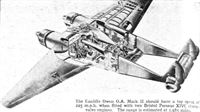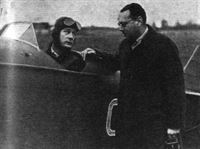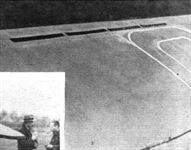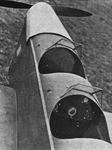Фотографии
-
AFTER THE TYRE BURST: One of the new Douglas DB-7 bombers came to rest like this after a take-off on the Los Angeles aerodrome. The pilot, Bill Coyne, was unhurt, but the undercarriage collapsed and the airscrews were bent somewhat
Самолёты на фотографии: Douglas A-20 Boston / Havoc / P-70 Nighthawk - США - 1938
-
A Merlin-engined Armstrong Whitworth Whitley bomber as now in service with the Royal Air Force.
Самолёты на фотографии: Armstrong Whitworth Whitley / A.W.38 - Великобритания - 1936
-
The King is seen leaving an Armstrong Whitworth Whitley bomber
Самолёты на фотографии: Armstrong Whitworth Whitley / A.W.38 - Великобритания - 1936
-
One of the earlier type Messerschmitt Me 109 single-seater fighters being refuelled at the Aspern aerodrome near Vienna. The machine has a Junkers Jumo 210 engine of 650 h.p. and quite a low performance.
Самолёты на фотографии: Messerschmitt Bf.109 / Bf.109B / Bf.109C / Bf.109D - Германия - 1935
-
Starting the Jumo 210 engine of a Messerschmitt Me 109 single-seater fighter. The armament of this type is four machine guns.
Самолёты на фотографии: Messerschmitt Bf.109 / Bf.109B / Bf.109C / Bf.109D - Германия - 1935
-
Though the Messerschmitt Me 110 was used in Poland, information on the type is very scarce. Here are some of these fast twin-engined fighters beneath a formation of Me 109s.
Самолёты на фотографии: Messerschmitt Bf.109 / Bf.109B / Bf.109C / Bf.109D - Германия - 1935Messerschmitt Bf.110 - Германия - 1936
-
The installation of the Daimler-Benz DB 600 in a Messerschmitt Me 109 fighter
Самолёты на фотографии: Messerschmitt Bf.109 / Bf.109B / Bf.109C / Bf.109D - Германия - 1935
-
This photograph shows what "A. Viator" would call a Besserschmitt, which landed in Denmark after running short of fuel. It appears to be of the older type with Junkers engine and wooden fixed-pitch airscrew.
Самолёты на фотографии: Messerschmitt Bf.109 / Bf.109B / Bf.109C / Bf.109D - Германия - 1935
-
One of the Messerschmitt Me 109 single-seater fighters which was brought down in French territory after an engagement with French Curtisses. On this occasion nine Frenchmen ere said to have attacked twenty-seven Germans and to have brought down nine. Reports vary considerably.
Самолёты на фотографии: Messerschmitt Bf.109 / Bf.109B / Bf.109C / Bf.109D - Германия - 1935
-
CIVIC PRIDE: A corner of the huge crowd which attended the official opening of New York’s Municipal Airport at North Beach, Long Island. The cost of constructing the airport is said to have been 40 million dollars
Самолёты на фотографии: Douglas DC-3 / C-47 Skytrain/С-53 Skytrooper / Dakota - США - 1935
-
TEMPORARILY IMMOBILISED: Douglas DC.3s and DC.2s of the K.L.M. in a hangar “somewhere in Holland.” It is hoped that most of these machines will soon be able once more to go about on their lawful occasions.
Самолёты на фотографии: Douglas DC-1 / DC-2 / C-32 / C-39 - США - 1933Douglas DC-3 / C-47 Skytrain/С-53 Skytrooper / Dakota - США - 1935
-
A Do 215 as powered with radials which may be B.M.W. 132 Dc’s or Bramo Fafnirs.
Самолёты на фотографии: Dornier Do.17Z / Do.215 - Германия - 1939
-
The Dornier Do 215 as fitted with Daimler-Benz DB 601 engines.
Самолёты на фотографии: Dornier Do.17Z / Do.215 - Германия - 1939
-
On the left the B.M.W. VI Prestone-cooled upright vee-twelve, as installed in the earlier Dornier Do 17. On the right Daimler-Benz DB 601, as fitted in the newer Dorniers. Note the rearward-facing exhaust stubs.
Самолёты на фотографии: Dornier Do.17 - Германия - 1934Dornier Do.17Z / Do.215 - Германия - 1939
-
A Flight copyright study of the “business end” of a Daimler-Benz-powered Do 215.
Самолёты на фотографии: Dornier Do.17Z / Do.215 - Германия - 1939
-
The centre engine of the Do 24 is set rather higher than the outboard units. It will be noted in this view that the bow turret has been retracted.
Самолёты на фотографии: Dornier Do.24 - Германия - 1937
-
The hull of the Do 24 is broad in the beam and quite roomy. This view shows the navigator's compartment. The box-like device on the right of the chart table appears to be part of the inter-communication system.
Самолёты на фотографии: Dornier Do.24 - Германия - 1937
-
The Dornier Do 24 showing the gun turrets in the bow, aft of the wing and in the tail.
Самолёты на фотографии: Dornier Do.24 - Германия - 1937
-
The tail gun position on the Do 24 follows British practice. It is fairly safe to assume that the German turrets are considerably inferior to our own.
Самолёты на фотографии: Dornier Do.24 - Германия - 1937
-
Bombs of various sizes can be slung beneath the wings of the Do 24 outboard of the sponsons. It will be seen that the racks are of neat design.
Самолёты на фотографии: Dornier Do.24 - Германия - 1937
-
A French Curtiss single-seater fighter of the squadron which is said to have engaged twenty-seven Messerschmitts. The engine is a Pratt and Whitney Twin Wasp. It will be noticed that the wing guns are covered. The machine shown has four Brownings but later versions have six.
Самолёты на фотографии: Curtiss Hawk 75 / P-36 / Mohawk - США - 1935
-
The Heinkel He 111 K bomber is being employed extensively for strategical reconnaissance. One of these machines, which are supposed to do something like 270 m.p.h., is seen through the front gunner’s position of a similar aircraft.
Самолёты на фотографии: Heinkel He-111P/H - Германия - 1938
-
The left-hand view shows the pilot’s instrument panel and the generous amount of “transparency” provided in the nose. The section outlined is shown enlarged in the right-hand picture. The rev. counter has been struck by a bullet and stopped at 1,800 r.p.m.
Самолёты на фотографии: Heinkel He-111P/H - Германия - 1938
-
Brought down at the Scottish village of Humbie, near Dalkeith, this Heinkel in bomber was riddled by machine gun bullets. The smaller holes are made by the bullets entering, the larger by them leaving.
Самолёты на фотографии: Heinkel He-111P/H - Германия - 1938
-
Bent and broken, the wreck of the Heinkel 111, brought down in the Lammermuirs last Saturday, still remains sufficiently intact to make a close study instructive. The engines are of Junkers direct-injection type.
Самолёты на фотографии: Heinkel He-111P/H - Германия - 1938
-
A short-nosed Heinkel bomber which was brought down by two British fighters near Hazebrouck after each had fired one burst. The pilot was killed before the machine reached the ground; one member of the crew had a bullet in the back and the other two escaped uninjured.
Самолёты на фотографии: Heinkel He-111P/H - Германия - 1938
-
A piece of the structure bearing the marks of the battle, and finally, Der Adler minus a few feathers. It will be noted that the machines are operating on 87-octane fuel.
Самолёты на фотографии: Heinkel He-111P/H - Германия - 1938
-
When a large-diameter spinner is used, the cowling of the DB 601 inverted-vee twelve is by no means unsightly, as shown in the view of the nose of a Heinkel He 112U.
Самолёты на фотографии: Heinkel He-112 - Германия - 1935
-
Fitted with two Bristol Pegasus XVIII engines the Handley Page Hampden bomber has a top speed 265 m.p.h. It is armed with four machine guns.
Самолёты на фотографии: Handley Page Hampden / H.P.52 - Великобритания - 1936
-
A Flight composite picture of what the rear gunner of a Do 17 might see of a Hurricane eight-gun fighter as it broke off its attack. The story of a fight between a Hurricane and a Do 17 is told in the following pages. It is related how a young New Zealander caught up with his quarry at 27,000ft. and, giving it "all he had," sent it crashing into a village. By a stroke of good fortune none of the villagers was killed.
Самолёты на фотографии: Dornier Do.17 - Германия - 1934Hawker Hurricane - Великобритания - 1935
-
HITTING POWER: With their eight machine guns the Hawker Hurricanes have proved themselves formidable opponents.
EARLY ECHELON: A flight of three Hurricanes from the first squadron to be equipped with eight-gun fighters.Самолёты на фотографии: Hawker Hurricane - Великобритания - 1935
-
Самолёты на фотографии: Hawker Hurricane - Великобритания - 1935
-
Регистрационный номер: OY-DAL NEUTRALITY: A Ju. 52 of the Danish Air Lines used on the Copenhagen-Berlin route. The “Dannebrog” is difficult to mistake for any other flag.
Самолёты на фотографии: Junkers Ju.52/3m - Германия - 1931
-
Germany's new Junkers Ju 88 high-speed twin-engined bomber. There is probably internal stowage, but it is certain that bombs are also carried beneath the centre section. It is believed that the type can be used for dive-bombing.
So far as can be gathered from a small Leica transparency showing the machine at a distance, the Junkers Ju 88 bomber looks essentially like this Flight “reconstruction.”Самолёты на фотографии: Junkers Ju.88 - Германия - 1936
-
The latest installation of the Junkers Jumo 211 in the Ju 88 high-speed bomber.
Самолёты на фотографии: Junkers Ju.88 - Германия - 1936
-
It has been said that the Ju 88 has auxiliary surfaces at the tips of its tailplane, as shown, but this is unconfirmed.
Самолёты на фотографии: Junkers Ju.88 - Германия - 1936
-
An annular nose-type radial characterises the installation of the Jumo 211 in the latest Junkers bombers. This is used in conjunction with controllable gills. It will be seen that the exhaust stubs are of the rearward-facing type.
Самолёты на фотографии: Junkers Ju.88 - Германия - 1936
-
When French machines come home with German bullet holes in them small swastikas are sometimes applied to the points of entry. Here is a Potez 63 after treatment.
Самолёты на фотографии: Potez Potez 63 - Франция - 1936
-
The King studies the pilot’s cockpit of a Supermarine Spitfire single-seater fighter.
Самолёты на фотографии: Supermarine Spitfire - Великобритания - 1936
-
YOUNG FOR THEIR YEARS: A pair of Amiot 143 bombers of the French Air Force flying in cosy formation are “intercepted” by a Dewoitine D.510 single-seater fighter also with a long background of service. These aircraft are being replaced by types which bear comparison with, and on certain points may be superior to, any military machines in the world.
Самолёты на фотографии: Amiot Amiot 140 / Amiot 143BN5 - Франция - 1931Dewoitine D.500 / D.510 - Франция - 1932
-
Самолёты на фотографии: Fairey Battle - Великобритания - 1936
-
In France the Battle squadrons are dropping live bombs on the ranges. A flight of these machines is seen above “attacking” with ordinary practice bombs.
Самолёты на фотографии: Fairey Battle - Великобритания - 1936
-
Регистрационный номер: K7558 Its good take-off and landing qualities enable the Battle to operate from aerodromes of comparatively small dimensions. It will be seen above how the fine lines of the machine are broken up when the wheels and flaps are lowered.
Самолёты на фотографии: Fairey Battle - Великобритания - 1936
-
A GOOD BACKGROUND: Pilots of the Belgian Air Force get together before a trim line-up of their Fairey Battle bombers. The version of the Battle supplied to Belgium is basically similar to the R.A.F. type but has a longer radiator cowling and a smoother camouflage finish, both of which refinements contribute to a slightly improved performance. The Battle is used not only for bombing but for strategical reconnaissance duties.
Самолёты на фотографии: Fairey Battle - Великобритания - 1936
-
The answer is in the negative. A member of the crew of a Fairey Battle passes the exposed plates to photographer for development. Curiously enough, this particular photographic Battle bears the letters "M.Q."
A Battle has no sooner rolled to a standstill after a reconnaissance flight over the lines than the photographic plates are passed down to waiting hands.Самолёты на фотографии: Fairey Battle - Великобритания - 1936
-
In France the Battles are camouflaged while on the ground by special nets or are screened by trees or haystacks. The view shows a typical scheme.
Самолёты на фотографии: Fairey Battle - Великобритания - 1936
-
A flight of Battles at formation practice.
Самолёты на фотографии: Fairey Battle - Великобритания - 1936
-
Регистрационный номер: L6886 The Westland Lysander II, an extremely efficient army co-operation machine, fully slotted and flapped and fitted with a Bristol Hercules sleeve-valve engine.
Самолёты на фотографии: Westland Lysander - Великобритания - 1936
-
Регистрационный номер: G-ADSR The Armstrong Whitworth Ensign is one of the largest transport land planes now flying, having a span of 123 ft. and a loaded weight of 46,500 lb.
Самолёты на фотографии: Armstrong Whitworth Ensign / A.W.27 - Великобритания - 1938
-
The installation of a B.M.W. 132 Dc radial in an Arado Ar 95 general purpose biplane.
Самолёты на фотографии: Arado Ar.95 - Германия - 1936
-
Регистрационный номер: L3057 Both the Blackburn Roc (shown) and the Boulton Paul Defiant are fitted with a Boulton Paul multi-gun power-driven turret. The Roc, which was designed for service with the fleet, has a Bristol Perseus engine while the Defiant has a Rolls-Royce Merlin. Both types are built by Boulton Paul Aircraft, Ltd
Самолёты на фотографии: Blackburn Roc / B-25 - Великобритания - 1938
-
The obliterated markings indicate that this Do 17 (B.M.W. VI’s) was taking part in manoeuvres.
Самолёты на фотографии: Dornier Do.17 - Германия - 1934
-
PUBLIC PARADE: Dornier Do 17 bombers "strut their stuff" during a pre-war mass fly-past. The version of the Do 17 shown has B.M.W. VI engines; later machines have Daimler-Benz inverted-vees, or B.M W or Bramo radials.
Самолёты на фотографии: Dornier Do.17 - Германия - 1934
-
The largest piece of the Do 17 found after it had dived vertically from over 20,000ft. was this section of the tail.
Самолёты на фотографии: Dornier Do.17 - Германия - 1934
-
A few pieces of the Do 17 which was shot down by a Hurricane. In the centre is the end of a machine-gun magazine. There are two pieces of the stressed-skin covering, a section of the extruded spar (top right) and part of a crank.
Самолёты на фотографии: Dornier Do.17 - Германия - 1934
-
A radial-engined Do 17 showing the field of fire of the top gun.
Самолёты на фотографии: Dornier Do.17 - Германия - 1934
-
The Do 17. This drawing is based on one executed by Max Millar at the Dornier works.
Самолёты на фотографии: Dornier Do.17 - Германия - 1934
-
DISTINGUISHED SERVICE has already been done by Vickers Wellington I bombers, two of which aircraft are seen over the sea in the Flight photograph. The Wellington does 265 m.p.h. and is the biggest of the R.A.F.’s landplane bombers.
Самолёты на фотографии: Vickers Wellington / Type 271 - Великобритания - 1936
-
The Vickers Wellington I bomber does 265 m.p.h. with two Bristol Pegasus XVIII engines.
Самолёты на фотографии: Vickers Wellington / Type 271 - Великобритания - 1936
-
The installation of a Jumo 205 diesel in a Junkers Ju 86. The airscrew is a V.D.M. electrically operated type.
Самолёты на фотографии: Junkers Ju.86 - Германия - 1934
-
On the factory tarmac at Melbourne, the first Australian-built “Wirraways.”
Самолёты на фотографии: Commonwealth (CAC) CA-1 / CA-3 Wirraway - Австралия - 1939
-
Building “Wirraways” at the Melbourne works of the Commonwealth Aircraft Corporation. The machine is of American design, its designation being NA33. The engine is a Pratt and Whitney Wasp.
Самолёты на фотографии: Commonwealth (CAC) CA-1 / CA-3 Wirraway - Австралия - 1939
-
Регистрационный номер: A5-4 Wapitis did good service until the Ansons arrived. Leggings, as on the right, are unknown in our R.A.F.
Самолёты на фотографии: Westland Wapiti - Великобритания - 1927
-
SEA PATROL: A Saunders-Roe Lerwick flying boat (two Bristol Hercules) over a familiar coastal land mark.
Самолёты на фотографии: Saunders-Roe Lerwick / S.36 - Великобритания - 1938
-
The impressive appearance of the big four-engined Short Sunderland is accentuated by the “sea-camouflage”
Самолёты на фотографии: Short Sunderland / S.25 - Великобритания - 1937
-
Регистрационный номер: K5772 The biplane is the Supermarine Walrus, an amphibian which is operated from the catapults of warships.
Самолёты на фотографии: Supermarine Walrus/Seagull V - Великобритания - 1933
-
A small view of a Jumo 205 engine
Самолёты на фотографии: Dornier Do.18 - Германия - 1935
-
The Service type Do 18 is generally similar to the long-range aircraft built for Lufthansa. There are unprotected gun-rings in the bows and on top of the hull aft of the wing. Bombs may be carried under the outer wing panels.
Самолёты на фотографии: Dornier Do.18 - Германия - 1935
-
The Flight sketches actually made from a Do 18 of the German Air Force at the Friedrichshafen works of the Dornier Company, show the ingenuity displayed in of the twin Junkers Jumo 205 diesel engines. lt will be noted that the rear engine drives its V.D.M. variable-pitch air screw through a shaft of considerable length. The small sketch shows the peculiar longitudinal steps and the twin water rudders.
Самолёты на фотографии: Dornier Do.18 - Германия - 1935
-
NAVAL NOVELTY: The Curtiss XSO-3C1 with a twelve-cylinder inverted-vee Ranger engine is a new American type for operation from warships. Its float undercarriage is among the cleanest yet designed. Visibility is obviously very good indeed and the machine should be quite fast for one of its type.
The alighting gear of this Curtiss observation seaplane shows the American tendency towards a single float.Самолёты на фотографии: Curtiss SO3C Seamew - США - 1939
-
THE FRENCH NAVAL AIR ARM: A Liore reconnaissance flying-boat - the equivalent of our Supermarine Walrus - operating in the Mediterranean. This is a very sturdy though, of course, slow machine.
Самолёты на фотографии: Loire Loire 130 - Франция - 1934
-
Регистрационный номер: A4-6 [2] The ubiquitous Avro Anson is in service not only in the R.A.F. but in the air forces of several other countries. The machines shown are Australian.
Самолёты на фотографии: Avro Anson / Type 652 - Великобритания - 1935
-
Регистрационный номер: A4-6 [2] Avro Ansons flying over Mascot aerodrome. A portion of Sydney may be seen in the background.
Самолёты на фотографии: Avro Anson / Type 652 - Великобритания - 1935
-
The Blackburn Skua (Bristol Perseus XII) is a two-seater fleet fighter dive-bomber used by squadrons of the Fleet Air Arm.
Самолёты на фотографии: Blackburn Skua / B-24 - Великобритания - 1937
-
Регистрационный номер: L4442 THE CAMOUFLAGE CULT: A production-type Bristol Beaufort multi-purpose monoplane as now being introduced into squadrons of the R.A.F. It has been stated that this machine is appreciably faster even than the Blenheim Mk.IV, which means that it does 300-and-some m.p.h. The engines are small-diameter Bristol Taurus sleeve-valve radials. Beauforts are to be built on a large scale, not only in England, but in Australia.
Самолёты на фотографии: Bristol Beaufort - Великобритания - 1938
-
MULTI-PURPOSE: A new picture of the Bristol Beaufort multi-purpose monoplane. It can function as a bomber, torpedo carrier, or strategical reconnaissance aircraft, and is powered with two of the new Bristol Taurus 14-cylinder sleeve-valve radials, which are notable for their small dimensions in relation to power.
Самолёты на фотографии: Bristol Beaufort - Великобритания - 1938
-
One of the newest types to go into service with the R.A.F. is the Bristol Beaufort (two Taurus engines) which can function as a bomber, reconnaissance machine, torpedo carrier, or general purpose type.
Самолёты на фотографии: Bristol Beaufort - Великобритания - 1938
-
IN THE FLEET AIR ARM: Instruction in the use of the camera gun at one of the training bases "Somewhere in England." The particular aircraft used for this training is a Fairey Swordfish.
Самолёты на фотографии: Fairey Swordfish - Великобритания - 1934
-
READY TO GO: Lockheed Hudsons awaiting repeal of the Neutrality Act at Alhambra, California.
Самолёты на фотографии: Lockheed Hudson A-28 / A-29 - США - 1938
-
AND THE AMERICAN: Vought and Curtiss dive-bombers of the U.S. Navy make a majestic spectacle as they fly past in mass formation over the Pacific. The formation also contains some Douglas monoplane torpedo bombers which correspond to our T.S.R. machines.
Самолёты на фотографии: Northrop BT - США - 1935Vought SB2U Vindicator / V-156 - США - 1936
-
The Bristol Bombay bomber transport which is built at the Short and Harland works.
Самолёты на фотографии: Bristol Bombay / Type 130 - Великобритания - 1935
-
The “Harrow” tanker as it appears from the aircraft being refuelled.
Самолёты на фотографии: Handley Page Harrow / H.P.54 - Великобритания - 1936
-
FIXED SLOTS FOR THE CHILTON: Differing from the usual “built-in” slots, this type also has been found effective in preventing wing-dropping at the stall, unless extreme rudder is used. The top speed is unaffected, and the handling qualities, including aerobatics, are unchanged.
Самолёты на фотографии: Chilton D.W.1 - Великобритания - 1937
-
General arrangement of tne Chilton Twin which, with two 90 h.p. engines, would have a top speed of 160 m.p.h. It is a four/five seater with a retractable tricycle undercarriage.
Самолёты на фотографии: Chilton D.W.1 - Великобритания - 1937
-
The design of the De Havilland Queen Bee wireless-controlled target machine is based on that of the Tiger Moth trainer. The machine is of all-wooden construction; this improves the flotation qualities.
Самолёты на фотографии: De Havilland Queen Bee / D.H.82B - Великобритания - 1935
-
Регистрационный номер: G-AFUE With two Bristol Perseus sleeve-valve engines the De Havilland Flamingo has a maximum continuous cruising speed of 220 m.p.h. flying at a weight of 17,000 lb.
Самолёты на фотографии: De Havilland Flamingo / D.H.95 - Великобритания - 1938
-
One of the most efficient and practical light aircraft in the world - the G.A. Cygnet.
Самолёты на фотографии: General Aircraft Cygnet II / GAL.42 - Великобритания - 1939
-
Регистрационный номер: A1-34, A1-35, A1-56 Over the Commonwealth, two flights of Hawker Demons.
Самолёты на фотографии: Hawker Demon - Великобритания - 1932
-
The late Mr. Skinner about to start in a Miles Master.
Самолёты на фотографии: Miles Kestrel M.9 / Master I M.9A - Великобритания - 1937
-
The nose of a Miles Master advanced trainer (Rolls-Royce Kestrel XXX). It will be seen that the radiator is mounted under the fuselage behind the engine.
Самолёты на фотографии: Miles Kestrel M.9 / Master I M.9A - Великобритания - 1937
-
Регистрационный номер: G-AFMS The attractive little Mosscraft monoplane with Cirrus Minor engine.
Самолёты на фотографии: Mosscraft MA-1 / MA-2 - Великобритания - 1937
-
Регистрационный номер: VH-ABL A Percival Q6 light transport as fitted with a retractable undercarriage. The engines are Series II Gipsy Sixes.
Самолёты на фотографии: Percival Petrel / Q.6 - Великобритания - 1937
-
Регистрационный номер: NC18602, NX18602, ZK-AMA THROUGH THE PORTHOLE: An unusual view of Pan American’s California Clipper berthed in Mechanics Bay, Auckland, New Zealand. The picture was taken from the Short Empire boat Aotearoa.
Самолёты на фотографии: Boeing Boeing 314 Clipper - США - 1938Short Empire / S.23 - Великобритания - 1936
-
Регистрационный номер: VH-ABD One of the Short Empire flying boats which operate the route to Australia. This particular one belong Qantas Empire Airways.
Самолёты на фотографии: Short Empire / S.23 - Великобритания - 1936
-
The new Wicko Windsor trainer will utilise as much as 75 per cent. of the parts of the high-wing Wicko.
Самолёты на фотографии: Foster Wikner Wicko - Великобритания - 1936
-
NEW YORK’S NEW AIRPORT AT NORTH BEACH, L.I.: In the foreground is the seaplane base, with a Clipper at moorings. In the background can be seen the six huge hangars, of semi-circular formation.
Самолёты на фотографии: Boeing Boeing 314 Clipper - США - 1938
-
AMUSING BUT USELESS: By refuelling from a car, as shown in the picture, the world’s endurance record was broken by W.E.S. Carroll and Clyde Schlieper on this light seaplane. Their total time in the air was 726 hours, and they "lifted" 3,000 gallons of petrol from the car. Not our idea of good clean fun.
Самолёты на фотографии: Piper Cub J-3/J-4 / L-4 Grasshopper / PA-11 - США - 1937
-
The writer, between pilot Woods and Birks, before a trip in from Wallal station on 90-Mile Beach, south of Broome.
Самолёты на фотографии: Bristol Tourer - Великобритания - 1919
-
Two 24-cylinder Napier Dagger H-shaped air-cooled engines power the Hereford bomber as built in the Short and Harland works.
Самолёты на фотографии: Handley Page Hereford / H.P.53 - Великобритания - 1937
-
Roscoe Turner’s Laird with a Pratt and Whitney Twin Wasp Engine.
Самолёты на фотографии: Laird-Turner LTR / RT-14 Meteor - США - 1936
-
Регистрационный номер: G-AFCI Golden Hind, first of the Short 'G' class flying boats fitted with four Bristol Hercules sleeve-valve engines.
Самолёты на фотографии: Short S.26 G-class - Великобритания - 1939
-
Described by Mr. Morrison as “the very fastest Menasco-powered airplane ever built,” Tony LeVier’s monoplane was first designed by Keith Rider and later redesigned by William Schoenfeld.
Самолёты на фотографии: Rider R-1 / R-2 / R-4 / R-5 / R-6 - США - 1931
-
Регистрационный номер: NX96Y The Keith Rider Eightball was not quite ready for the Races.
Самолёты на фотографии: Rider R-1 / R-2 / R-4 / R-5 / R-6 - США - 1931
-
Регистрационный номер: NC191M The trim monoplane below it will be recognised as one of our Miles Sparrow Hawks. This also turned up at the National Air Races.
Самолёты на фотографии: Miles Sparrowhawk / M.5 - Великобритания - 1935
-
Регистрационный номер: K8309 The Hotspur was an experimental two-seater fighter built by the Hawker Company some time back.
Самолёты на фотографии: Hawker Hotspur - Великобритания - 1938
-
The Wittman Special (Curtiss D-12) which took fourth place in the Thompson race.
Самолёты на фотографии: Wittman D-12 Bonzo - США - 1936
-
The Marcoux-Bromberg was used this year by Earl Ortman to fly his last race.
Самолёты на фотографии: Rider R-3 - США - 1934
-
The Dart Weasel is a trainer with a tricycle undercarriage, split flaps and twin fins and rudders.
Самолёты на фотографии: Dart Weasel - Великобритания - 1938
-
The Cunliffe Owen O.A. Mark II should have a top speed of 225 m.p.h. when fitted with two Bristol Perseus XIVC sleeve-valve engines. The range is estimated at 1,985 miles.
Самолёты на фотографии: Cunliffe-Owen OA-1 Clyde Clipper - Великобритания - 1939
-
A new training aircraft which has acquitted itself well in trials is this attractive Parnall monoplane. The engine is a D.H. Gipsy Six. In the version shown the rear cockpit is enclosed.
Самолёты на фотографии: Parnall Model 382 / Heck III - Великобритания - 1939
-
The Crosby CR-4 has a 260 h.p. Menasco. It averaged 244 m.p.h. in the Thompson race.
Самолёты на фотографии: Crosby CR-4 - США - 1938
-
The Murphy “over and under” machine shown here is a stunt contraption which can be landed in the inverted position. The engine is a 65 h.p. Continental.
Самолёты на фотографии: Murphy Over-and-Under - США - 1935
-
Регистрационный номер: G-AFZX [6] Самолёты на фотографии: Marendaz Trainer - Великобритания - 1939
-
Регистрационный номер: G-AFZX [6] Mr. D. M. K. Marendaz talks it over with his test pilot, Mr. R. A. Wyndham.
Самолёты на фотографии: Marendaz Trainer - Великобритания - 1939
-
Регистрационный номер: G-AFZX [6] The built-in wing tip slots are one of the modern features of the Marendaz Trainer.
Самолёты на фотографии: Marendaz Trainer - Великобритания - 1939
-
Регистрационный номер: G-AFZX [6] An unusual type of undercarriage is fitted. The wheels roll sideways in a landing.
Самолёты на фотографии: Marendaz Trainer - Великобритания - 1939
-
Регистрационный номер: G-AFZX [6] The three-quarter rear view brings out the clean lines.
Самолёты на фотографии: Marendaz Trainer - Великобритания - 1939
-
Регистрационный номер: G-AFZX [6] The spartan simplicity of the instrument panels has an appeal which is likely to be but temporary.
Самолёты на фотографии: Marendaz Trainer - Великобритания - 1939
Статьи
- Flight
- Flight Advertisements
















